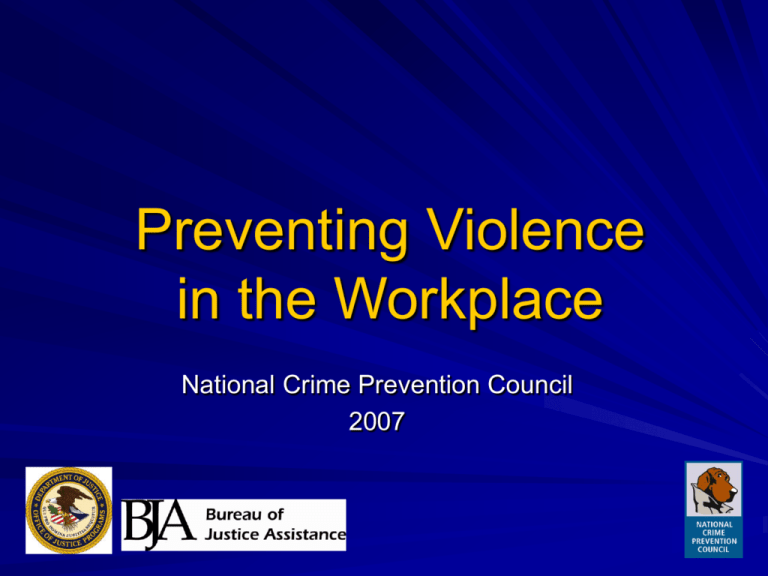
Preventing Violence
in the Workplace
National Crime Prevention Council
2007
A portion of this presentation is
provided by
Tom Carney
North Miami Beach Police Department
for the
Florida Crime Prevention Association
16901 NE 19th Avenue
North Miami, FL 33162
Business Health Services
1-800-765-EAPS
www.bhsonline.com
2
National Crime Prevention Council
Goal of This Presentation
Participants will learn about workplace
violence, including legal issues,
prevention, intervention, and response.
3
National Crime Prevention Council
Presentation Objectives
Define workplace violence
Review The Occupational Safety and
Health Act of 1970
Discuss the primary elements of a
workplace violence prevention program
and policy
Discuss pre-employment screening
Learn about negligent hiring and retention
4
National Crime Prevention Council
Presentation Objectives (continued)
Identify the characteristics of employee
disenchantment
Review stalking and workplace violence
Learn ways to prevent workplace violence
during termination
Discuss the elements of crime prevention
through environmental design
Examine the various aspects of physical security
5
National Crime Prevention Council
It is estimated that nearly 25
percent of all workplace
violence goes unreported.
Source: Business Health Services
6
National Crime Prevention Council
Definition of Workplace Violence
Any act against an employee that creates
a hostile work environment and
negatively affects the employee, either
physically or psychologically
7
National Crime Prevention Council
Four Types of Workplace
Violence
The person who came to commit the crime
• Has no relationship to the workplace
• Is the recipient of a service
• Has an employment relationship with a current or
former employee
• Has a personal relationship with a current or
former employee
Source: Workplace Violence: Issues in Response,
U.S. DOJ, FBI
8
National Crime Prevention Council
Why Be Concerned About
Violence in the Workplace?
It makes sound business sense
Avoid exposure to litigation
Safety of employees
9
National Crime Prevention Council
Financial Impact of Workplace
Violence on American Businesses
Each year almost 1 million individuals
become victims of violent crime while working.
About 500,000 victims of violent crime in the
workplace lose an estimated 1.8 million work
days each year.
The average cost to Amercian businesses
each year is estimated to be $36 billion dollars.
Source: Bureau of Justice Statistics
10
National Crime Prevention Council
Legal Issues Involved in
Workplace Violence Lawsuits
Often lawsuits involve
Negligent hiring
Negligent retention
Negligent supervision
Inadequate security
11
National Crime Prevention Council
Training Is the Key
12
National Crime Prevention Council
The Occupational Safety and
Health Act of 1970
13
National Crime Prevention Council
OSHA Guidelines
Not mandatory
Implementation reduces citations for
violations of the General Duty Clause
14
National Crime Prevention Council
Management Commitment
Toward Employees
Zero-tolerance policy
Allocate sufficient resources
Develop a system of accountability
Provide medical and psychological counseling
Study trends and security measures
Implement training and educational programs
15
National Crime Prevention Council
Excerpt From the National Crime
Prevention Council’s Workplace
Violence Guidelines
“The National Crime Prevention Council maintains
a zero-tolerance policy …”
“Violation of this policy may result in disciplinary
action, up to and including termination from
employment. Additionally, violations of this
policy will also be reported to the appropriate
authorities when warranted and therefore may
be subject to civil and/or criminal charges or
penalties.”
16
National Crime Prevention Council
Excerpt From the National Crime
Prevention Council’s Workplace
Violence Guidelines (continued)
“All NCPC associates should immediately report to
management or Human Resources any
threatening behavior that they witnessed, were
subjected to, or of which they have knowledge.
Human resources will investigate any suspected
incident of violent or threatening behavior and
take appropriate action. No associate shall be
subject to retaliation or retribution of any kind for
reporting a suspected incident of workplace
violence.”
17
National Crime Prevention Council
Primary Elements of an
Effective Workplace
Violence Prevention Program
Planning
Policies
Training
Physical Security
18
National Crime Prevention Council
Basics of Planning
Threat assessment team
Assess current conditions
Establish and implement policies
Employee Assistance Program
19
National Crime Prevention Council
Basics of Planning (continued)
Develop a training program
Prepare a crisis response plan
Test and improve the program on a
regular basis
20
National Crime Prevention Council
Basics of Policy
Periodic updates to policies
Review by legal counsel and insurance carrier
Review and update procedures to implement policies
Training on Policies and Procedures
Emphasize new and amended policies
21
National Crime Prevention Council
Basics of Training
Review workplace violence policies
Implement and/or discuss your
Employee Assistance Program
Practice effective pre-employment
screening methods
Train management and employees
22
National Crime Prevention Council
Basics of Training (continued)
Effective termination and layoff
practices
Recognize and report potential
workplace violence problems
Review crisis response plan
23
National Crime Prevention Council
Basics of Physical Security
Conduct a threat assessment
Incorporate Crime Prevention Through
Environmental Design (CPTED)
strategies
24
National Crime Prevention Council
Pre-Employment
Screening
and
Hiring
25
National Crime Prevention Council
Pre-Employment Screening
Check references
Developed sources
26
National Crime Prevention Council
Hiring and Retention
Look for warning signs
What is negligent hiring?
What are foreseeable circumstances?
What are propensities?
27
National Crime Prevention Council
Hiring and Retention (continued)
Current wisdom—give the barest of facts
when contacted for job references
versus
“Affirmative duty” to disclose negative
information
28
National Crime Prevention Council
Factors Leading to
Workplace Violence
Employee Disenchantment
Absenteeism
Turnover
Three Levels of Violence
Aggressive Behavior
29
National Crime Prevention Council
Employee Disenchantment
Disenchanted employee is another term
for disgruntled employee. This person
may not be happy with his or her
supervisor or with the job itself, or may
be unhappy because of personal
circumstances that have carried over to
the workplace. A person who is
disenchanted in the workplace could
show the propensity toward workplace
violence.
30
National Crime Prevention Council
Employee Disenchantment
(continued)
Employee disenchantment can result from
Confusion
Lack of trust
Office politics
Meaningless job
Employee not knowing if he or she is
succeeding in his or her job performance
Boss takes credit for employee’s work
31
National Crime Prevention Council
Absenteeism
Reasons for chronic absenteeism include
Conflict with management style
Working conditions
Employees’ relationships with one another
Personal problems
75% of all absenteeism is relationship-based
32
National Crime Prevention Council
The Three Levels of Violence
33
National Crime Prevention Council
Levels of Violence: Level One
The employee
Refuses to cooperate with immediate supervisor
Spreads rumors and gossip
Consistently argues with co-workers or
management
Is belligerent toward customers
Swears at others
Makes unwanted sexual comments
34
National Crime Prevention Council
Levels of Violence: Level Two
The employee
Refuses to obey company policy
Sabotages equipment and steals property
Verbalizes wishes to hurt co-worker(s) or
management
Writes sexually violent notes
Sees self as victimized by management
35
National Crime Prevention Council
Levels of Violence: Level Three
The employee
Has suicidal thoughts
Has physical fights on the job
Uses weapons
Commits violent acts/crimes
36
National Crime Prevention Council
Aggressive Behavior
in the Workplace
37
National Crime Prevention Council
Aggressive Workplace Behavior
Involves
Fear
Intimidation
Alarm
Emotional Distress
Anger
Capitulation
Punishment
Anxiety
38
National Crime Prevention Council
Examples of Aggressive
Workplace Behavior
Include
Harassment (telephone, written, face-to-face)
Stalking
Threats
Inappropriate communications
Trespassing or returning to the workplace
after being told to leave
39
National Crime Prevention Council
Examples of Aggressive
Workplace Behavior
(continued)
Occupying or entering victim’s dwelling
and/or vehicle
Falsely impersonating with an intent to
harass
Making unwanted purchases in the victim’s
name
40
National Crime Prevention Council
How to Handle a Potentially
Violent Situation
41
National Crime Prevention Council
Handling Violent Situations
Familiarize yourself with your company’s policies
and emergency procedures
Report any physical or verbal threats
Never touch the violent person
Use a calm, nonconfrontational approach
Take all threats seriously
Familiarize yourself with the resources available
Seek immediate assistance if the situation
escalates
42
National Crime Prevention Council
If It’s an Emergency Situation
Call 911 and building security personnel if you
have them
Make sure to make the call using a phone that is
out of the sight and hearing of the violent person
If you can, stay on the line until the police arrive
Do not intervene physically
Get yourself and others to a safe place as soon
as possible
43
National Crime Prevention Council
Examples of Violence in the
Workplace
Domestic Violence,
Stalking, and Workplace
Violence
44
National Crime Prevention Council
Domestic Violence
is emotional abuse, physical abuse, or sexual
abuse between people who have, at some
time, had an intimate or family relationship.
Source: www.findcounseling.com
45
National Crime Prevention Council
Domestic Violence
Examples of Emotional Abuse
Emotional abuse is when an abuser
Continuously criticizes, calls names, or shouts
Insults or drives friends or family away
Humiliates a person in private or public
Keeps a person from working, controls the money, or makes
all the decisions
Refuses to work or to share money
Takes the car keys or money
Regularly threatens to leave or tells a person to leave
Threatens to kidnap the children when angry
Manipulates with lies and contradictions
46
National Crime Prevention Council
Domestic Violence
Examples of Physical Abuse
Physical abuse is when an abuser
Pushes, shoves, kicks, or chokes
Holds a person down to keep them from leaving
Hits, slaps, or bites
Throws objects
Locks a person out of the house
Abandons a person in dangerous places
Refuses to help when a person is sick, injured, or
pregnant
Forces a person off the road or drives recklessly
Threatens to hurt a person with a weapon
47
National Crime Prevention Council
Domestic Violence
Examples of Sexual Abuse
Sexual abuse is when an abuser
Minimizes the importance of a person’s feelings about
sex
Criticizes a person sexually
Insists on unwanted or uncomfortable touching
Withholds sex and affection
Forces sex after physical abuse or when a person is sick
Rapes a person
Is jealously angry, assumes a person will have sex with
anyone
Insists that a person dresses in a more sexual way than
they want to
48
National Crime Prevention Council
Stalking
There are two broad categories of stalking.
Unwanted pursuit by a stranger
Unwanted pursuit by someone the victim
knows
49
National Crime Prevention Council
Signs of Possible Victimization
Frequent or unplanned
leave
Change in job
performance
Unexplained bruises or
injuries
Sudden change of
address
Depression
50
Eating disorders
Self neglect
Panic attacks
Anxiety
Drug and alcohol
dependence
National Crime Prevention Council
Employer Reaction and Support
Confirmation that the threat exists
Foster a supportive workplace climate
Thoughtfully encourage co-worker disclosure
Staff training
51
National Crime Prevention Council
Employer Reaction and Support
(continued)
Evaluate the threat
Create an intervention plan
Notify and involve law
enforcement
Keep in close contact with
the victim
52
National Crime Prevention Council
Employer Reaction and Support
(continued)
Make referrals
Learn whether court orders have been
obtained
Allow for time off for victim
Review and modify work spaces
Be mindful of privacy
Notify other employees as appropriate
53
National Crime Prevention Council
Employee Assistance Program
Services
Can provide information on traumatic events
to the employer and its employees
Can provide counseling services to victim
Can assist in analyzing the situation and
developing strategies
54
National Crime Prevention Council
Ways to Prevent Workplace
Violence When Terminating
an
Employee
55
National Crime Prevention Council
Performance Appraisals
Always give honest and direct performance
measurements
Explain, discuss, and document poor
performance
Provide training to strengthen problem areas
56
National Crime Prevention Council
Unsatisfactory Performance
Address unsatisfactory
performance as it occurs
Be honest
Choose retraining and
internal placement if
possible
57
National Crime Prevention Council
During the Termination Process
Carefully review the employee’s
personnel background. There is rarely a
good time to be let go.
58
National Crime Prevention Council
During the Termination Process
Prepare and Plan
Who will conduct the exit interview?
Who should witness the meeting?
How will the remaining staff be told?
What about the employee’s personal
possessions?
Will anyone in the company react emotionally?
Will there be an extra workload?
59
National Crime Prevention Council
During the Termination Meeting
Provide a written script
Role play beforehand
Keep it brief
60
National Crime Prevention Council
During the Termination Meeting
(continued)
Design and choose a specific place
Do not use your office
Consider Closed Circuit Television (CCTV) and
a panic button
Have an exit predetermined
Ensure security is available if necessary
61
National Crime Prevention Council
After the Termination Meeting
Collect keys
Severance pay
Continue medical benefits and other
assistance programs
Separation agreement
Be respectful in front of other employees
62
National Crime Prevention Council
After the Termination Meeting
(continued)
Allow employee to retrieve personal effects
Answer follow-up questions promptly
Resist the urge to return threats
Offer support; disarm anger by listening and
showing empathy
63
National Crime Prevention Council
Safety Tips in
the Workplace
64
National Crime Prevention Council
Safety Tips in the Workplace
Keep your purse, wallet, keys, or other valuables
with you at all times or locked in a drawer or
closet.
Check the identity of any strangers who are in
your office.
Don’t stay late if you’ll be alone in the office.
Report any broken or flickering lights, dimly lit
corridors, broken windows, and doors that don’t
lock properly.
65
National Crime Prevention Council
Safety Tips in the Workplace
(continued)
If you notice signs of potential violence in a
fellow employee, report this to the appropriate
person.
Immediately report any incidents of sexual
harassment to your supervisor and/or human
resources department.
If the company does not supply an emergency
kit, keep your own emergency supplies.
Avoid using out-of-the-way corridors and
stairwells when you’re alone.
66
National Crime Prevention Council
Physical
Security
67
National Crime Prevention Council
Physical Security
Exterior Access Control
Property border
Parking lot
Entrance doors
Gates, fencing, guards, CCTV, alarm system
68
National Crime Prevention Council
Physical Security (continued)
Interior Access Control
Main entrance
Main lobby
High security areas
Locked doors, enclosed counters, bulletproof
glass, CCTV, guards, cash handling
procedures, etc.
69
National Crime Prevention Council
Physical Security (continued)
Be Prepared
Emergency plan(s)
Code word(s)
Safe rooms
Electronic door access card
Key control
Unmarked parking spaces
70
National Crime Prevention Council
Preventing Violence in the
Workplace:
For Businesses
Crime Prevention Through
Environmental Design
(CPTED)
71
National Crime Prevention Council
CPTED: Access Control
A space should give some natural
indication of where people are and are
not allowed to go. Don’t just depend on
locks and guards. Make security part of
the layout.
72
National Crime Prevention Council
An Example of Access Control
73
National Crime Prevention Council
CPTED: Natural Surveillance
Criminals don’t want to be seen. Placing
physical features, activities, and people in
ways that maximize the ability to see
what’s going on, discourages crime.
74
National Crime Prevention Council
An Example of Natural Surveillance
75
National Crime Prevention Council
CPTED: Territorial
Reinforcement
People protect territory they feel is their
own and respect others’ territory. Fences,
pavement treatments, art, signs, good
maintenance, and landscaping are some
physical ways to express ownership.
76
National Crime Prevention Council
An Example of
Territorial
Reinforcement
77
National Crime Prevention Council
CPTED: Activity Support
Encouraging legitimate activity in public spaces
helps discourage crime. Outside lunch areas or
places to relax during breaks provide visible
deterrents to potential criminals and support
territoriality by employees.
78
National Crime Prevention Council
An Example of Activity Support
79
National Crime Prevention Council
CPTED: Maintenance
Proper maintenance of landscaping, lighting
treatment, and other features can facilitate the
principles of CPTED.
80
National Crime Prevention Council
An Example of Maintenance
81
National Crime Prevention Council
Questions
or
Comments?
82
National Crime Prevention Council
Resources
83
National Crime Prevention Council
Resources: Websites
Occupational Safety and Health Act
www.osha.gov
Workplace Solutions
www.wps.org
National Center for Victims of Crime
www.ncvc.org
Free Management Library
www.managementhelp.org/emp_well/violence.htm
84
National Crime Prevention Council
Resources: Documents
Workplace Violence Prevention and Response
Guidelines, ASIS International, September 2005
www.asisonline.org/guidelines/guidelineswpvfinal.pdf
USDA Handbook on Workplace Violence Prevention and
Response, U.S. Department of Agriculture, 1998
www.usda.gov/news/pubs/violence/wpv.htm
Workplace Violence Issues in Response, National
Center for the Analysis of Violent Crime, Critical Incident
Response Group, Federal Bureau of Investigation, 2002
www.fbi.gov/publications/violence.pdf
85
National Crime Prevention Council
Resources: Publications
Office of Personnel Management, Dealing with
Workplace Violence, A Guide for Agency Planners,
February 1998.
Defense Personnel Security Research Center, Private
Sector Liaison Committee of the International
Association of Chiefs of Police, Combating Workplace
Violence, Guidelines for Employees and Law
Enforcement, July 1994.
Kenneth Wolf et al, Helping the Employee Recover From
the Trauma of Workplace Violence, EAP Digest, March
4, 1994.
Department of the Air Force, Violence in the Workplace
Intervention Handbook, December 1995.
86
National Crime Prevention Council
The National Crime Prevention
Council
2345 Crystal Drive
Fifth Floor
Arlington, VA 22202
202-466-6272
FAX 202-296-1356
www.ncpc.org
Used with permission from Tom Carney,
North Miami Beach Police Department and Business Health Services
87
National Crime Prevention Council
Presenter Contact Information
88
National Crime Prevention Council








